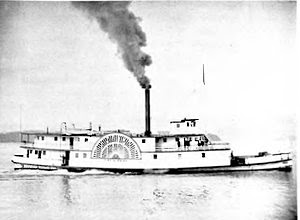Dr. Richard M. Allen was in Skagway in the winter of 1897 as seen in the photo above. He is in the dark outfit leaning on the post. His descendent, Natalie Gohrband kindly allowed me to post this previously unseen family photo. Family lore says he died on a shipwreck at the Kuskokwim River in 1899, but it could have been on the Jessie which sank there in 1898. It was described in a book by Gordon Newell titled the Shipwrecks of 1899, so that may be the source of the confusion.
The Jessie swamped in turbulent water at the mouth of the Kuskokwim River on June 28, 1898. Rev. Welsh and 18 miners from the Columbia Exploration Company were believed to have been massacred by the Yupik Natives or lost in the wreck. One person, a trader called Ling survived and sent word to St. Michael of the shipwreck.
http://www.alaska.boemre.gov/ref/ships/2011_shipwr/2011_Shipwreck.pdf;








